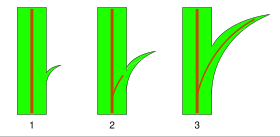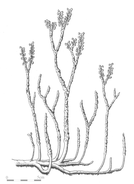Lycophyte
| Lycophyte | |
|---|---|

| |
| Collage of modern lycophytes. Upper left: Selaginellales
| |
| Scientific classification | |
| Kingdom: | Plantae |
| Clade: | Tracheophytes |
| Clade: | Lycophytes |
| Classes | |
| |
The lycophytes, when broadly
The scientific names and the informal English names used for this group of plants are ambiguous. For example, "Lycopodiophyta" and the shorter "Lycophyta" as well as the informal "lycophyte" may be used to include the extinct zosterophylls or to exclude them.
Description
Lycophytes reproduce by
Zosterophylls and extant lycophytes are all relatively small plants, but some extinct species, such as the Lepidodendrales, were tree-like, and formed extensive forests that dominated the landscape and contributed to the formation of coal.[6]
Taxonomy
Classification
In the broadest circumscription of the lycophytes, the group includes the extinct zosterophylls as well as the extant (living) lycophytes and their closest extinct relatives. The names and ranks used for this group vary considerably. Some sources use the names "Lycopodiophyta" or the shorter "Lycophyta" to include zosterophylls as well as extant lycophytes and their closest extinct relatives,[7] while others use these names to exclude zosterophylls.[8][6] The name "Lycopodiophytina" has also been used in the inclusive sense.[9][10] English names, such as "lycophyte", "lycopodiophyte" or "lycopod", are similarly ambiguous, and may refer to the broadly defined group or only to the extant lycophytes and their closest extinct relatives.
The consensus classification produced by the Pteridophyte Phylogeny Group classification in 2016 (PPG I) places all extant (living) lycophytes in the class Lycopodiopsida.[11] There are around 1,290 to 1,340 such species.[12][13][11] For more information on the classification of extant lycophytes, see Lycopodiopsida § Classification.
Phylogeny
A major cladistic study of land plants was published in 1997 by Kenrick and Crane.[1] In 2004, Crane et al. published some simplified cladograms, based on a number of figures in Kenrick and Crane (1997). Their cladogram for the lycophytes is reproduced below (with some branches collapsed into 'basal groups' to reduce the size of the diagram).[14]
| panlycophyte |
| |||||||||||||||||||||||||||
In this view, the "zosterophylls" comprise a
A rather different view is presented in a 2013 analysis by Hao and Xue. Their preferred cladogram shows the zosterophylls and associated genera basal to both the lycopodiopsids and the euphyllophytes, so that there is no clade corresponding to the broadly defined group of lycophytes used by other authors.[19]
|
"lycophytes" of other authors |
Some extinct orders of lycophytes fall into the same group as the extant orders. Different sources use varying numbers and names of the extinct orders. The following phylogram shows a likely relationship between some of the proposed Lycopodiopsida orders.[citation needed]
| Lycopodiopsida |
| ||||||||||||||||||
Evolution of microphylls

Within the broadly defined lycophyte group, species placed in the class
Gallery
-
Lycopodites, an early lycopod-like fossil
-
External mold ofUpper Carboniferous of Ohio.
-
Lycopod bark showing leaf scars, from the Middle Devonian of Wisconsin.
-
Fossil in situlycopsid, probably Sigillaria, with attached stigmarian roots.
-
Base of a fossillycopsid showing connection with stigmarian roots.
-
Reconstruction of a Silurian Zosterophyllum
-
Reconstruction ofNothia aphylla
-
Reconstruction of Lepidodendron
-
Lycopod axis (branch) from the Middle Devonian of Wisconsin.
-
Lycopodiales
-
Isoetes melanospora, a modern member of the Isoetales
-
Restoration of Pleuromeia, an extinct Isoetales genus from the Early Triassic
References
- ^ ISBN 978-1-56098-730-7.
- S2CID 131287538.
- ISBN 978-0-19-850065-0.
- ^ Ranker, T. A.; Hauler, C. H. (2008). Biology and evolution of ferns and lycophytes. Cambridge: Cambridge University Press.
- ^ Eichhorn, Evert, and Raven (2005). Biology of Plants, Seventh Edition. 381-388.
- ^ ISBN 978-1-4496-6580-7.
- doi:10.12705/661.27.
- ISBN 978-0-12-373972-8.
- ISBN 978-1-56098-730-7.
- S2CID 3866183.
- ^ S2CID 39980610.
- ISBN 978-0-7487-4336-0.
- .
- S2CID 8493380.
- .
- ^ Taylor, Taylor & Krings (2009), p. 253.
- ISBN 978-0-231-11161-4.
- ^ Taylor, Taylor & Krings (2009), p. 250.
- ISBN 978-7-03-036616-0.
- ^ Taylor, Taylor & Krings (2009), p. 267ff.
External links
- Lycophytes
- Fossil Groves Archived 2009-03-12 at the Wayback Machine
- Paleo Plants (archived 15 January 2005)












